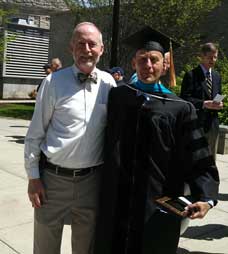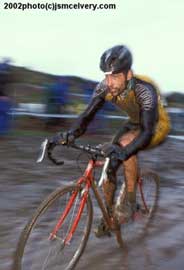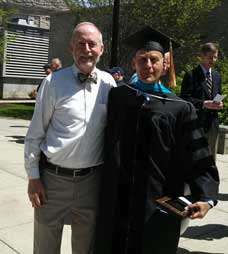 KINGSTON, R.I. – June 19, 2014 – Timothy Haitz was 30 years old when he discovered that one of his legs was an inch shorter than the other. Kids teased him during high school, calling him “swivel,” and now he finally knew why he couldn’t walk like the others.
KINGSTON, R.I. – June 19, 2014 – Timothy Haitz was 30 years old when he discovered that one of his legs was an inch shorter than the other. Kids teased him during high school, calling him “swivel,” and now he finally knew why he couldn’t walk like the others.
The man who gave Haitz the shocking news was Michael Noonan, a clinical instructor for the University of Rhode Island’s physical therapy program and owner of a private practice in South County.
Noonan made Haitz whole again, and Haitz returned the favor in a big way.
The now 48-year-old South Kingstown resident gave up his career as a commercial fisherman and became a physical therapist, graduating this spring with a doctorate from URI’s physical therapy program.
“Thank goodness I met Michael,” says Haitz. “He saved my life.”
“Tim is an amazing guy,” says Noonan. “He’s got a lot of integrity, and a lot of drive.”
Haitz was 14 years old when he was riding his bike home after baseball practice and a car hit him. He was thrown 20 feet and landed head first on the road. He broke his right leg and dislocated his pelvis and jaw. His injuries were so serious doctors recommended amputating his right leg above the knee. No way, his mother said.
He spent four days in a coma. He was in traction for three months. After that, he endured a hip cast for four months. “Physically, I was a mess,” says Haitz. “I didn’t walk for a year.” No more baseball, no more cross country running, no more hanging out with friends.
The accident came at a terrible time in his life. He was a growing teenager, but because of his injuries only half of his lower body developed normally. He made up for his shorter leg by “contorting my upper body to even myself out,” he says.
He developed something called functional scoliosis. Mean kids called him “swivel” for his awkward gait. “Still, even then, I was totally unaware of what was happening to me physically,” he says. “I was never re-evaluated after I got out of the hospital. I just grew into my injury.”
The years passed. He graduated from high school and joined his family’s commercial fishing business, spending weeks at a time on Lightning Bay and his family’s other trawlers fishing for cod, haddock and yellow tail flounder on the Eastern Seaboard.
His back ached constantly, sometimes so bad he couldn’t stand up straight. Still, “I just had to muddle through it,” he says. Eventually, he couldn’t take it any more and decided to seek a physical therapist. A friend recommended Noonan.
The diagnosis was swift. Not only was his right leg shorter, but he also had a left “ilial upslip,” which meant his pelvis had slipped upward over time. Also, the ligaments in his right knee and his hamstring muscles were shot, torn during the boyhood accident and never repaired.
The two got to work. Noonan used muscle energy techniques and “manual manipulation” to align Haitz’s pelvis. He put a one-inch heel lift in his shoe. Sometimes, Haitz would pay him with fish and lobsters.
 After months of therapy, Haitz started to feel like a new man. “I lived in pain, continuous pain, for years,” he says. “Michael gave me the inspiration and motivation to bring challenges back into my life.”
After months of therapy, Haitz started to feel like a new man. “I lived in pain, continuous pain, for years,” he says. “Michael gave me the inspiration and motivation to bring challenges back into my life.”
Haitz found a sport his body could handle – cycling. At first, he cycled for fun, then began to compete in races and discovered that he had enormous lung capacity. He went on to become a nationally ranked cyclist, winning titles at the state and regional levels, including the New England Single Speed Mountain Bike Championship three years in a row. He also competed internationally three times at the World Cyclocross Championships in Belgium, finishing 15th one year.
Noonan was not surprised by his patient’s success: “His drive and desire to get to an end is phenomenal.”
A decade ago, Haitz had one of those revelatory moments: He decided to switch careers. At the urging of his wife, Mia, a former URI math lecturer, and his mother-in-law, he enrolled at URI, earning his bachelor’s degree in exercise science in three years. Then he studied three more years to get his doctorate in physical therapy, or D.P.T.
“The faculty and professors were there for me and did everything they could to teach me how to be an exceptional physical therapist,” says Haitz. “It was a hands-on experience.”
Looking back, he is certain he chose the right path. “My life was changed by a physical therapist,” says Haitz, who is healthy and largely pain-free now. “My life was changed forever by a physical therapist.”
Noonan says he is just as grateful to Haitz.
“Wow, what a compliment that you could help someone change their lives to that degree,” he says. “In school, he didn’t just memorize facts; he understood everything. He’ll be a great physical therapist.”
And he won’t work far from Noonan. After he passes his national boards, Haitz will join Noonan’s practice, Physical Therapy Services of Rhode Island, in Wakefield and Wickford.
The instructor and student will heal others together. “As physical therapists we can change people’s lives on a daily basis,” says Haitz. “And that is powerful. Take my life.”
Pictured above:
Michael Noonan, a clinical instructor for the University of Rhode Island’s physical therapy program, and Timothy Haitz, who received his doctorate in physical therapy this spring at URI. Photo courtesy of Timothy Haitz.
Timothy Haitz, of South Kingstown, who received his doctorate in physical therapy this spring from the University of Rhode Island, competing in a cycling race. Photo by Jonathan S. McElvery.

